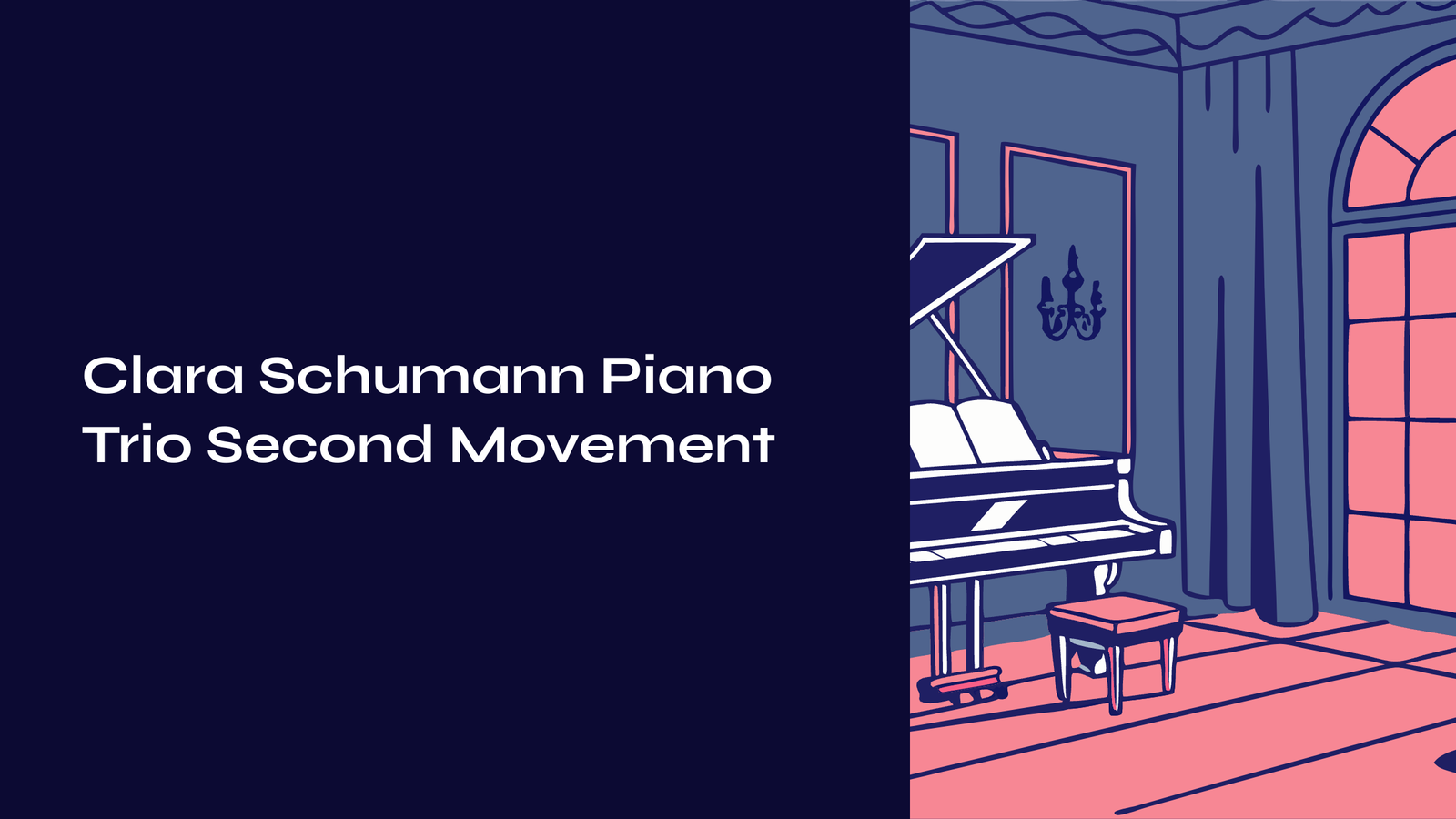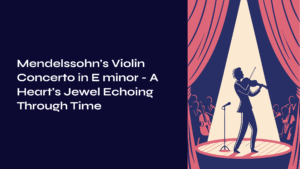Table of Contents

That Moment When Time Stands Still in Elegance
Some music transports you to another world the moment you hear it. The second movement of Clara Schumann’s Piano Trio in G minor, Op. 17, is exactly such music. Within the classical framework of Scherzo and Trio, she created music that resembles an elegant dance unfolding in a secret salon.
The moment the first notes begin to flow, you might find yourself under the illusion of sitting in the drawing room of some 19th-century German mansion. But this is not mere nostalgic longing for a bygone era. What Clara embedded in this music is a unique beauty born from the meeting of her delicate sensibility as a female composer with her profound understanding of classical forms.
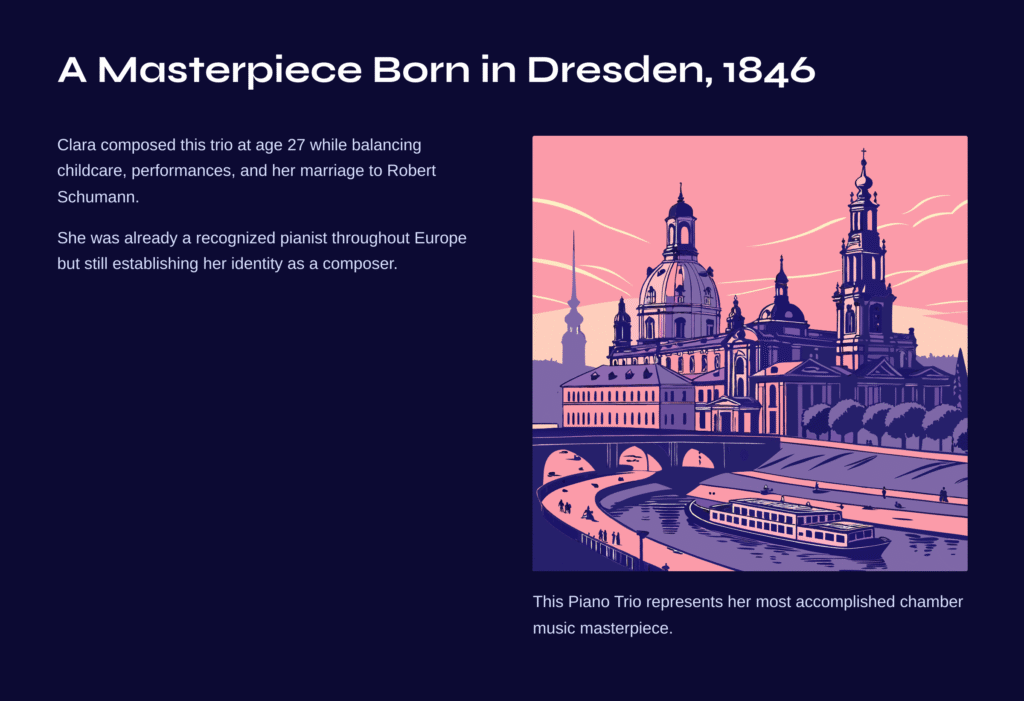
A Masterpiece Born in Dresden, Summer 1846
The year 1846, when Clara Schumann composed this trio, was special for her. It was a period when she was balancing childcare and performance activities within her marriage to Robert Schumann, while simultaneously seeking to find her own voice as a composer. Though Clara, then 27, was already a recognized pianist throughout Europe, she was still in the process of establishing her identity as a composer.
This Piano Trio is Clara’s only trio work and is considered the most accomplished masterpiece among her chamber music compositions. The second movement’s Scherzo and Trio, in particular, represents a section where the elegance of classical minuet and Romantic lyricism blend exquisitely, offering a glimpse into Clara’s distinctive musical language.
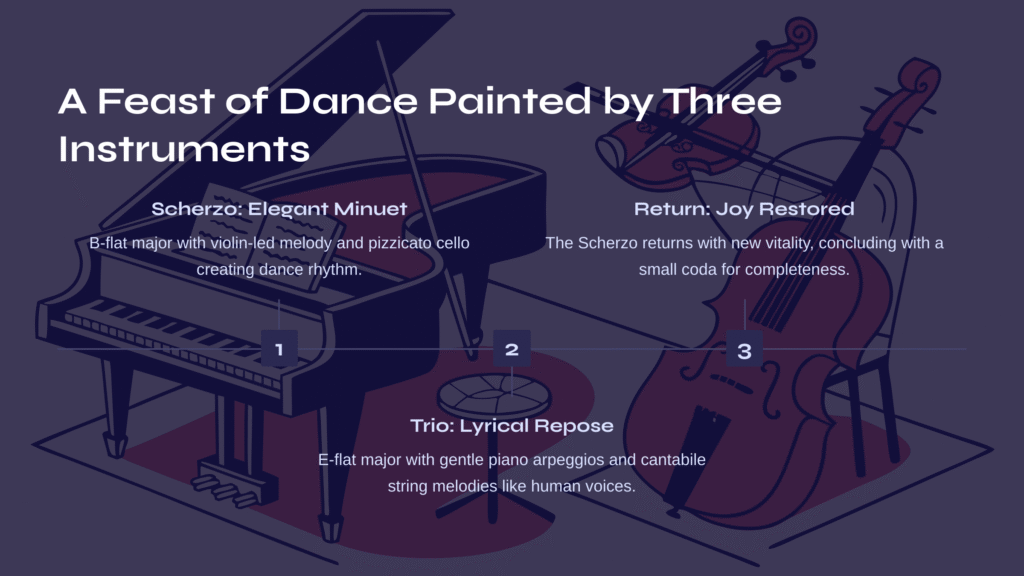
A Feast of Dance Painted by Three Instruments
Scherzo: An Elegant Minuet in B-flat Major
The second movement is constructed in typical ternary form (ABA). The opening Scherzo section begins in B-flat major, which Clara marked as “Tempo di minuetto.” This indicates her intention to aim not for a simple scherzo, but for the dignity of a classical-era minuet.
The violin-led melody possesses an elegance that might be heard at an aristocratic ballroom. What’s remarkable here, however, is the role of the cello. Played pizzicato, the cello transcends mere accompaniment to clearly present the dance rhythm while adding lightness to the overall atmosphere. Like gently bouncing footsteps, it breathes vitality into the music.
The piano provides harmonic support while occasionally presenting intriguing melodic lines in the inner voices, as if engaging in conversation with the other instruments. This demonstrates that Clara was not merely a pianist but a composer who deeply understood the balance of chamber music as a whole.
Trio: Lyrical Repose in E-flat Major
When the lightness of the Scherzo reaches its peak, the music suddenly guides us to another world. The Trio section, beginning with a modulation to E-flat major, sounds like the quiet conversation shared by dancers taking a brief rest.
Here, the piano presents a gentle arpeggiating melody, shifting the atmosphere. The string instruments then exchange cantabile melodic lines with each other. This section reveals Clara’s aspect as a song composer. The instruments sing like human voices, each possessing independent character while collectively forming one beautiful harmony.
Particularly noteworthy is the tonal coloring that appears in this Trio section. Clara occasionally layers minor coloring (especially A minor) over the basic tonality of E-flat major, simultaneously giving the music depth and warmth.
Return of the Scherzo: The Joy of Dance Restored
When the lyrical repose of the Trio concludes, the first Scherzo returns unchanged. However, to our ears that have already experienced the lyricism of the Trio, the same music sounds different. We can feel the new vitality and joy experienced by dancers who have briefly rested before leaping back onto the dance floor.
Clara doesn’t stop at simple recapitulation but concludes this movement through a small coda. The definitive cadence from B-flat to F gives the entire movement stability and completeness.
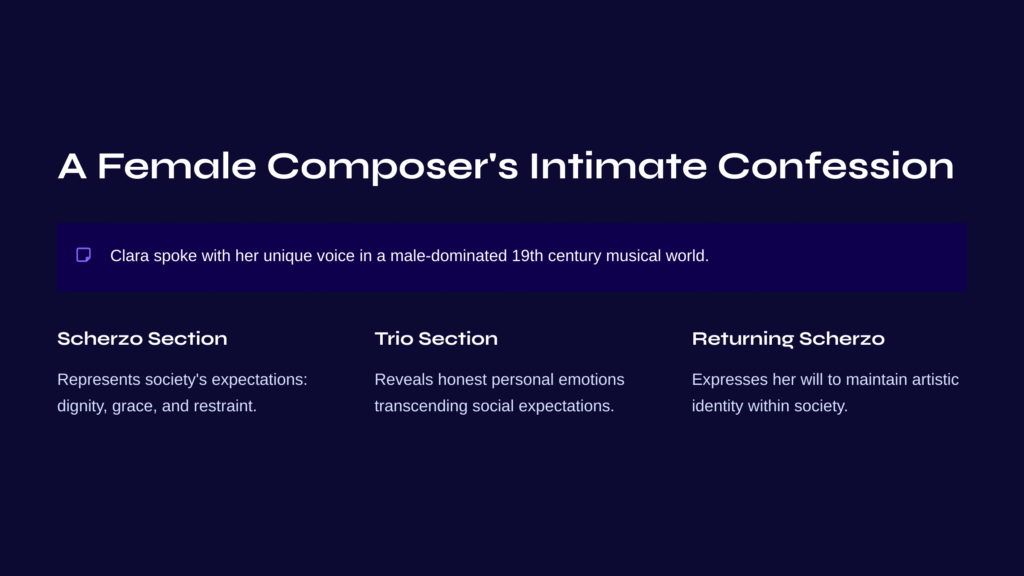
My Personal Interpretation: A Female Composer’s Intimate Confession
While listening to this music, I often find myself picturing Clara herself. Living as a female composer in the male-dominated musical world of the 19th century must not have been easy. Yet in this second movement, Clara speaks with her own unique voice.
The elegance of the Scherzo section might represent the virtues that society demanded of women at the time—dignity, grace, restraint. However, the deep lyricism and intimacy of the Trio section seems to reveal Clara’s honest personal emotions, transcending such social expectations.
And the returning Scherzo might be an expression of her will to ultimately live in harmony with society without losing her artistic identity. This may be merely my imagination, but isn’t the emotion that music provides ultimately born from such personal interpretation and resonance?
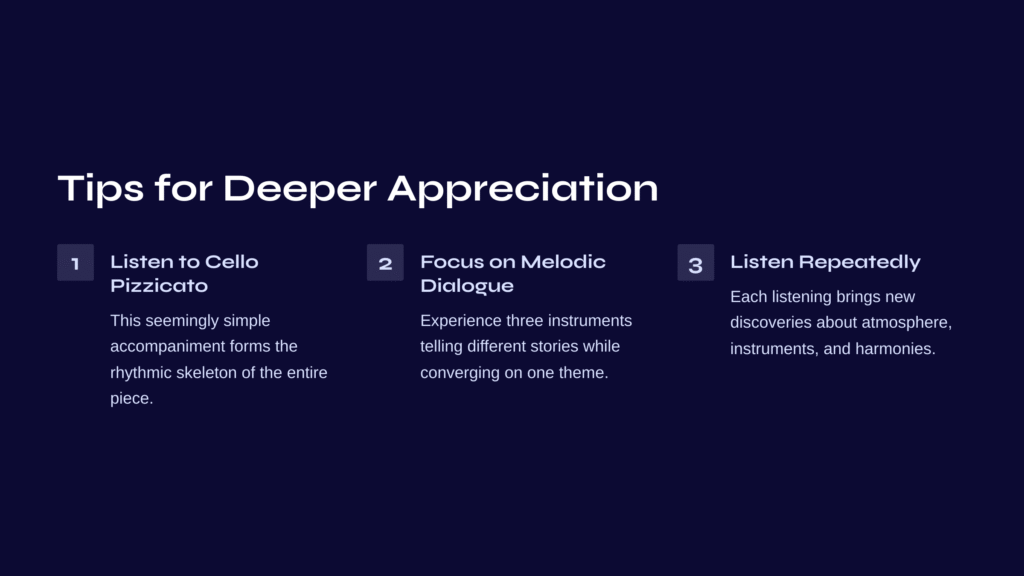
Tips for Deeper Appreciation
If you wish to appreciate this beautiful movement more deeply, I recommend focusing on several points.
First, listen carefully to the cello’s pizzicato passages. You’ll discover that this seemingly simple accompaniment actually forms the rhythmic skeleton of the entire music while serving as a key element that determines the dance-like character.
Second, concentrate on the melodic dialogue exchanged by the three instruments in the Trio section. You can experience the fascination of watching three friends tell different stories while ultimately converging on one theme.
Third, listen to this movement repeatedly. Focus on the overall atmosphere and flow the first time, on each instrument’s role the second time, and on harmonic changes and tonal coloring the third time—each listening will bring new discoveries.
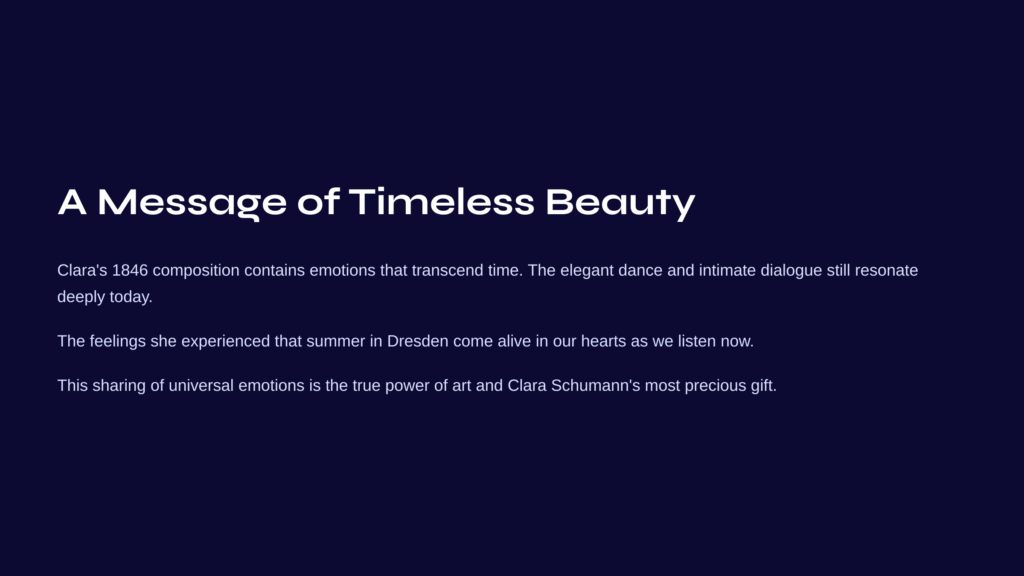
A Message of Timeless Beauty
Clara Schumann’s Piano Trio second movement, though composed in the 19th century, contains emotions and beauty that transcend time. The elegant dance and intimate dialogue, and the human emotions that bloom between them, still resonate deeply with us living in the 21st century.
The reason music transcends time lies precisely in this sharing of universal emotions. The feelings Clara experienced in that moment during the summer of 1846 in Dresden come alive again vividly in our hearts as we listen to this music today. This is the true power of art and the most precious gift Clara Schumann left us.
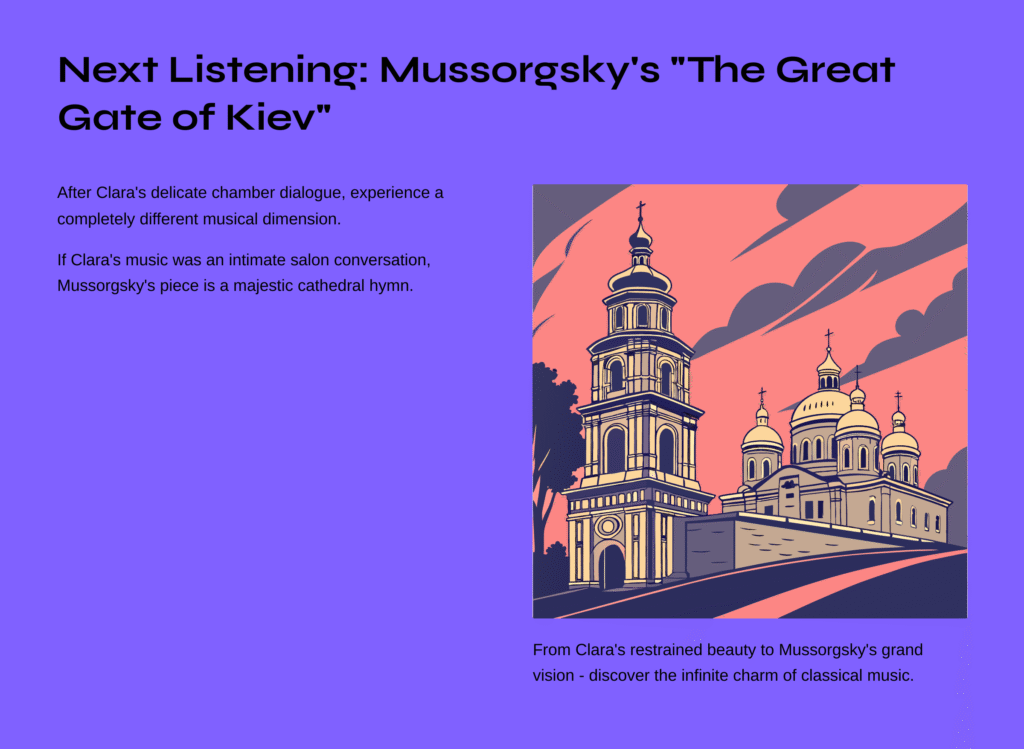
Next Listening Recommendation: Mussorgsky’s “Pictures at an Exhibition” – The Great Gate of Kiev
Having appreciated Clara Schumann’s delicate chamber music dialogue, I’d like to suggest a completely different dimension of musical experience. “The Great Gate of Kiev,” the final piece of Mussorgsky’s “Pictures at an Exhibition,” is a work that unfolds a grand narrative vision beyond the realm of personal emotion.
If Clara’s music was an intimate conversation in a salon, this piece by Mussorgsky is like a majestic hymn resounding in a vast cathedral. The powerful harmonic progressions reminiscent of Russian Orthodox church bells, combined with folk melodies, give listeners the impression of standing beneath Kiev’s golden domes.
From Clara’s restrained beauty to Mussorgsky’s grand vision—such contrasting appreciation is perhaps the shortcut to discovering the infinite charm of classical music. From one composer’s intimate confession to one nation’s magnificent dream, the spectrum of emotions that music can encompass is truly limitless.
